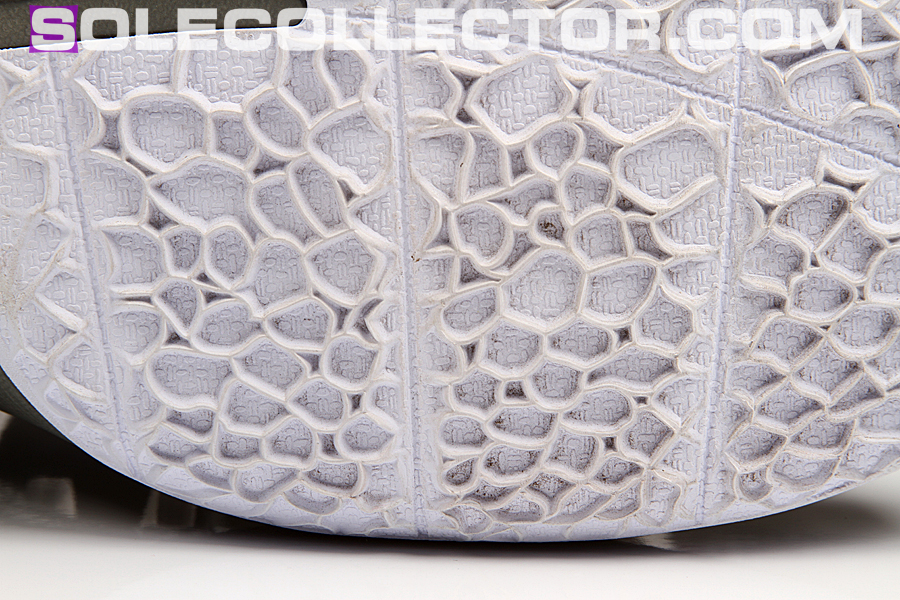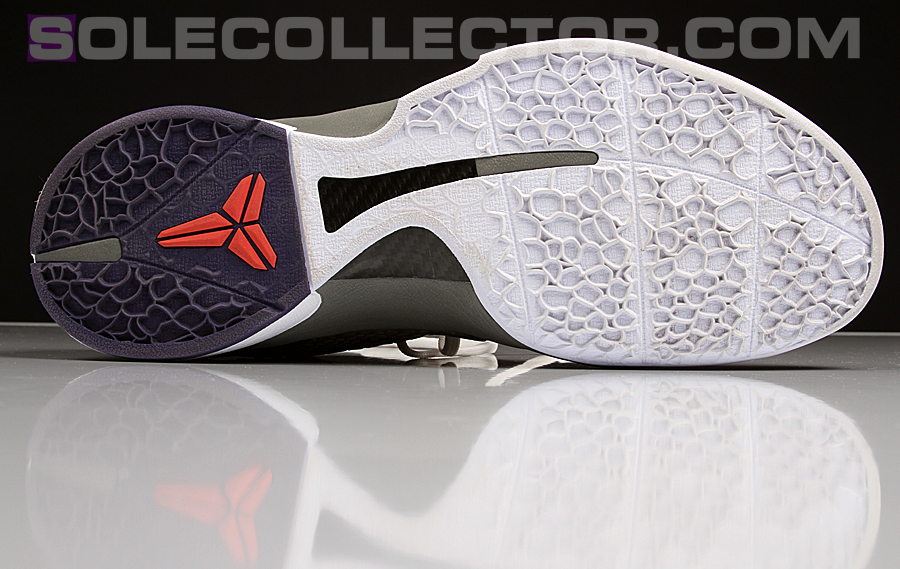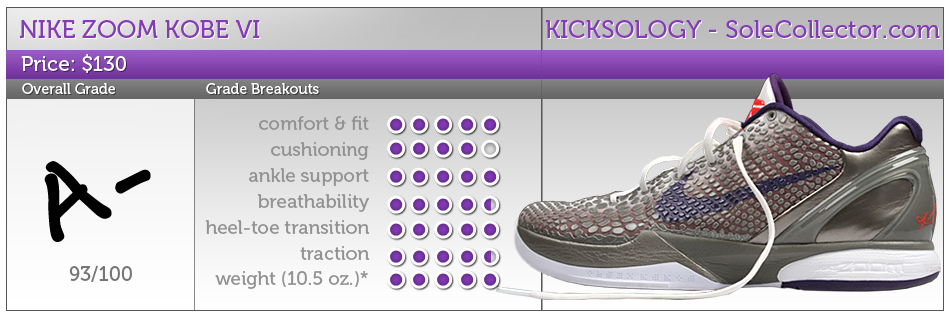
NIKE ZOOM KOBE VI | TWEAKS AWAY
words & images // Nick DePaula
It’s now the third season in a row that we've seen Kobe Bryant's signature footwear take us lighter and lower, year by year and model by model, and in my opinion, it's safe to say that the Zoom Kobe series is reaching its peak. They’re outstanding shoes, but can the shoe get any lower from here? Can it get even lighter? Where will the industry-shifting sneaker that was initially met with so much skepticism take us next?
 All of these questions were in the back of my mind as I hit the courts for a lengthy testing of the Zoom Kobe VI that began in mid-December. And, of course, I also had in mind all of the concerns and improvements I'd hoped to see made from the Zoom Kobe V, namely, traction and forefoot responsiveness. While the Kobe IV’s full-length herringbone pattern was screeching, dependable and blueprint-worthy on the traction front, the V's "cute" storytelling approach simply didn't cut it.
All of these questions were in the back of my mind as I hit the courts for a lengthy testing of the Zoom Kobe VI that began in mid-December. And, of course, I also had in mind all of the concerns and improvements I'd hoped to see made from the Zoom Kobe V, namely, traction and forefoot responsiveness. While the Kobe IV’s full-length herringbone pattern was screeching, dependable and blueprint-worthy on the traction front, the V's "cute" storytelling approach simply didn't cut it.
The fit was unreal, the weight and softness a true treat, and yet, the shoe was really a disappointment when it came to traction. Which just so happens to be the most unmesswithable part of a performance basketball sneaker. A lack of reliable grip, a lack of secure footing and stable cuts – and seriously, your entire game and approach will change. Gone was the biting aggressiveness found in the IV, and whenever I played in the V, as much as I loved all of its other top-line features, I never quite felt confident enough with sudden pull-up jumpers the same way I did just a year ago. So, yes, traction was indeed my number one point of interest with the VI, ’cause guess what, there's a cute pattern again. It definitely looks sweet, and plays off of the scales seen along the upper, but as you can imagine, I was instantly skeptical after the lower letdown in the Vs.
My other biggest concern was simply forefoot cushioning. It's the one area of the recent Zoom Kobe line that has always come up short for me. First it was the horribly unresilient Lunar Foam in the IV, and last year, while there was a cushioning change, only a 6mm Zoom Air met bag was incorporated, which left a lot to be desired along the lateral side for me, where simple foam was now liable. The good news is Lunar Foam seems to be a one-and-done deal in the Kobe namesake line, joining the ranks of Tech Flex in the history books of my favorite forgottens. The bad news is, the Zoom Kobe VI features the exact same cushioning setup that we saw in the V. A "straightshot," words Tom Luedecke, one of Nike's emerging top designers and the man responsible for much of the development behind the Kobe line.
Luckily, Tom addressed my concerns directly and candidly when we had a chance to chat all about the VI during a busy day of interviews this past December. “You were saying [about the V], ‘Hey, great shoe overall. However, forefoot cushioning; could you go Zoom across the entire forefoot?’” Luedecke recalls. “The Zoom bag going across the forefoot was not an option.” The biggest reasons Tom cites are not only Kobe’s specific preference, which surely counts for a lot, but also the lack of longitudinal flexibility that comes with a full-wide Zoom bag. “If you take a Zoom bag going across the forefoot, you’re basically creating a lever, and you can put a flex groove in the tooling, but it won’t really do anything, because your Zoom bag doesn’t flex, at least at this point in time,” he explains. With the full-wide bag, both Luedecke and Bryant aren’t so sure they’ll get the flex and response out of the shoe that they’re after. I totally understand that, and while I like the added bounce of a full-wide bag, for now, I’d have to deal with it.
With all of that in mind, and my two main concerns of traction and forefoot cushioning at the very top of my wish list, I set out for a two-month run in the Zoom Kobe VI. They shaped up pretty much where I expected, with a few positive surprises along the way.
To get it out of the way, I was once again relatively disappointed in the cushioning setup. But, I can understand why Tom would "listen to the athlete" more than take input from some chump like me, and potentially sacrifice the flexibility that Kobe so highly values. Much of the awesomeness of the Zoom Kobe line from a performance perspective comes from the sheer amount of insight and input that Kobe has. No other athlete, perhaps ever, is this vocal, direct and in tune with what his exact priorities, preferences and needs are.
Kobe is maniacally interested in the minor details – the millimeters even – and it's reflected in his product. In the few times we’ve gotten a chance to chat via the old telephone, he constantly talks about his quest to “not lose seconds,” which can even further be clocked at mere milliseconds with his first step. For him, he loves the cushioning platform first implemented in the Zoom Huarache 2K4, which includes a heel 12mm Zoom Air unit and a forefoot 6mm met head Zoom bag. He’s specifically asked for it once again, beginning last season with the Zoom Kobe V. He feels the firmer lateral half of the forefoot gives him a faster reaction on jabs, cuts and drives, and I can't really take too much issue with that. “We’ve tried other stuff, like in the Hyperdunk and the IV, and we were promptly re-directed by him, in terms of what his specific needs were,” laughs Luedecke.
It's not MY preferred setup, as I'll forgo the slight feedback for a bit more cushion, but his name is on it, and I'm also not exactly the explosive athlete that #24 is. I'm usually aiming for my sixth win of the night at 24 Hour Fitness. He's aiming for a sixth Larry O'Brien. I'm not crazy about the forefoot met Zoom Air unit, but I also love that Kobe is that involved. If your sole focus is on a lightning quick first step and having total control and ample court feel, then you should like the more balanced setup found in the VI.
If you're after maximum responsiveness in the forefoot, then you'll probably, like me, enjoy the full-width forefoot Zoom bag found in the Hyperfuse. The heel Zoom Air unit seen here (something lacking in the Hyperfuse) is perfectly responsive and soft, and I'd love for the forefoot to take on that more full and high volume rebound, without losing the flexibility that Kobe so dearly craves. Maybe that'll be something to look forward to down the road? “Going further, there might be a Zoom bag that can achieve that,” hints Luedecke.
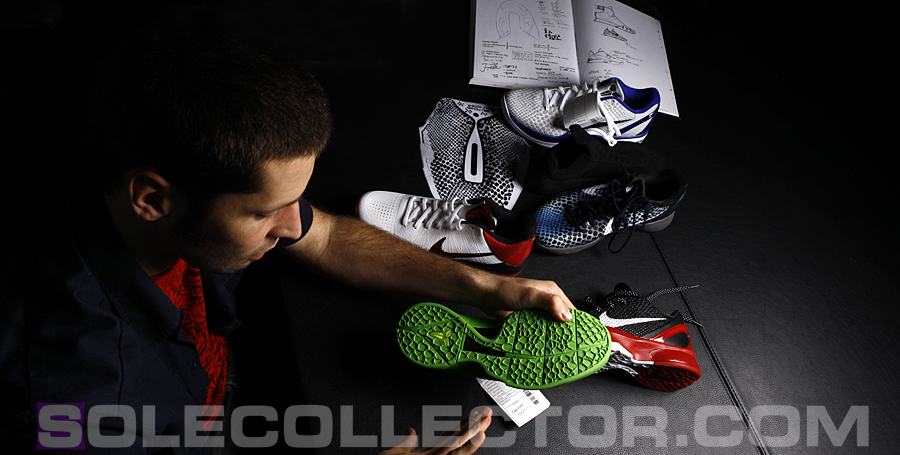
Above: Designer Tom Luedecke breaks down Kobe's long-standing preference for reaction time and flexibility.
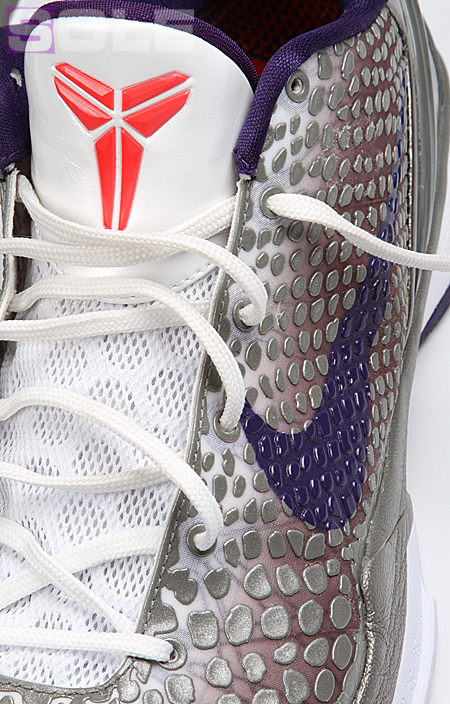 While the forefoot responsiveness was something I'd just have to deal with, and the shoe is certainly still very "comfortable" by industry standards, I'm generally far less lenient on less-than-stellar traction. It's a potential dealbreaker. Traction and transition are usually the two make-or-break items for me, and last year's pattern didn't give me as much hope going into this year with the VI.
While the forefoot responsiveness was something I'd just have to deal with, and the shoe is certainly still very "comfortable" by industry standards, I'm generally far less lenient on less-than-stellar traction. It's a potential dealbreaker. Traction and transition are usually the two make-or-break items for me, and last year's pattern didn't give me as much hope going into this year with the VI.
For the first three to five wearings on the VI, traction was as I expected – pretty marginal. I had to swipe often, and even then, was sliding when I'd rather not be. If you need reliable and durable traction right out of the box, and also want a nice ride and fit, I'd probably direct you towards the herringbone-based Hyperfuse and Zoom KD III. While the traction was entirely forgettable during my first week, it was also entirely surprising and an eventual bright spot, as it drastically improved later into my testing. I've never really seen that before. Usually, a shoe is who you thought it was from the start, but as I found in the VI's case, the rubber started to wear just a little and seriously improved its hold.
The noticeable difference meant a world of difference on the court. Cuts were sharper. Drives more confident. And, it was nice to see the pattern really prove itself out over time. The durability of the Zoom Kobe line has certainly come into question over the years, and for good reason, and I can say that the VI definitely offers the most durable outsole of the last three low-cut models. (If you happen to buy a China-launched version featuring an XDR outsole, you’ll have even better durability.)
There's a required break-in period that is definitely not ideal for your first few nights, but the traction will steadily improve over time, which is great. That's not to say that a full-length herringbone pattern wouldn't have been a better option from day one – it would've. But, as Luedecke explains, they want to have more fun with the product and tell connecting stories between the upper and outsole, so it's safe to say we'll be seeing more (hopefully) functional design patterns going forward.
Another returning element of the low-cut Kobe era is Flywire. It only happens to be far less noticeable because of the upper’s more prominently visible scale pattern. The scales are by all accounts a “love it or hate it” item from all of the feedback I’ve heard, from both friends and the vast Interwebs alike, but they offer up a nice performance benefit in that the upper flexes and flows better during play than the overly synthetic rands and overlays we saw in the Zoom Kobe IV and V.
The breaks throughout the upper flex smoothly, and the reduction of layers also means a closer-fitting shell. While Flywire plays a much less prominent role visibly on the VI, it's actually just as present as ever, staying undercover in most colorways and providing its cable-based structure for support. That was by design.
“Just like the Zoom bags aren’t exposed, the person who plays in Kobe products expects nothing less from us,” says Tom Luedecke. “If we were to come out and say there’s no Flywire, then everyone would say, ‘Well, what did you put in that’s better? You’ve been telling us that this is great, and we trust it, so why would you step away from that?’” The strand alignment of the nylon-woven support cables is pretty close to exactly what we saw in the V, only there’s a bit more hold through the medial arch in an effort to get even closer to the foot.
Overall, the upper has a bit more volume than the past two models, and carries over pretty much every major functional component that we’ve seen, only it flexes better and perhaps is more accommodating. Another aspect that's new to the shoe is the more sculpted sockliner that actually features a two-foam construction, with a more dense outter foam shell and a softer inner foam. Inspired by Kobe's quest for a "shoe that molds to my foot," the sockliner more nicely conforms to the slopes of your feet over time, with the outter shell keeping the insole from breaking down. It's not exactly the revolutionary custom and personalized fit that the team is constantly striving for, and might soon approach, but the engineered insole is a nice addition. As a result, the best-in-class fit found in the total package is certainly an industry benchmark.
Because the VI doesn’t veer too far from the tried and true best practices that the Kobe line has become known for, that we’ve also seen help to shape the rest of the Nike Basketball line, I really can’t complain about any other aspects of the shoe. The heel-to-toe transition is buttery smooth during play, and that’s a credit to its “credit card” sized midfoot shank and also the carefully sculpted Phylon midsole frame.
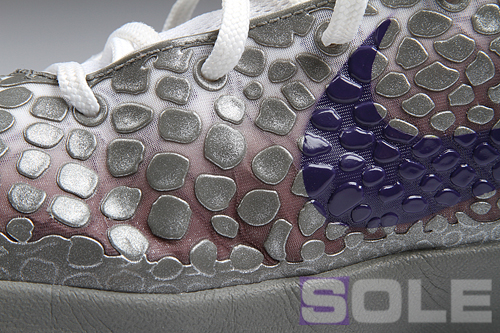
The shoe’s weight, at a mere 10.5 ounces in size 9, makes it once again one of the lightest shoes around, and the cushion, feathery weight and smooth ride make it an easy choice for guards and swift forwards. I’d expect to see the VI on players throughout the college and pro levels once again.
We’ve seen the Zoom Kobe series steadily improve each season without taking any huge risks, and once again, it’s an outstanding option for the basketball season. Not much has changed, but not much needed changing, either. “The flex pattern is a big departure in the forefoot, and the sockliner cupping is a big departure from the V, and an elevation,” feels Luedecke. “But the Zoom bags, foam and credit-card shank are all the same. We improved the heel counter, kept the heel foam about the same, and improved the upper.”
I’d have to agree. With my two biggest concerns – traction and forefoot responsiveness – addressed, and in the case of the met Zoom bag, explained, the Zoom Kobe VI shaped up to once again be one of the best-performing shoes of the season. The traction will take a few wearings to really break in and offer the bite you’re after, but the patience is worth it. The met Zoom bag is just something you’ll have to deal with if you crave the responsiveness that only a full-wide unit can offer. For those two reasons alone, I couldn't give the Zoom Kobe VI an even "A" grade.
Hopefully next year the cushioning will continue to evolve and improve, as Luedecke so nicely hinted. The combination of light weight, snug fit, range of motion and a smooth ride make for an outstanding performance sneaker, and it’s all at the same price point of $130 that the V was. If you care, the VI is the first Zoom Kobe shoe with its own box, so there’s that piece of perhaps added value, too. And as for the series perhaps reaching its peak, Tom Luedecke is already hard at work on where the future of the line might be taking us. “Like a Porsche, you don’t change the whole car, you choose your spots,” he explains. “One year it’s the transmission, one year it’s the motor. That’s how we approached it this year. Now, come the VII, you might see a very big departure, but I can only foreshadow so much.”
.jpg)
